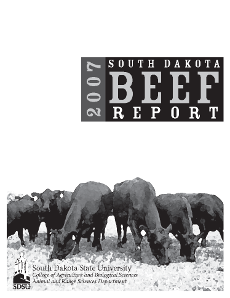Document Type
Report
Report Number
2007-5
Publication Date
2007
Keywords
pregnancy, progesterone, urea nitrogen, nutrition, post-AI
Summary
Research has shown that changes in nutrition can have an effect on reproductive performance. Our objective was to determine the effect of post-AI nutrition on BCS, blood urea nitrogen (BUN), progesterone, and pregnancy rates. Forage-developed Angus-cross bred heifers (n = 336) were synchronized with the Select Synch+ Controlled Internal Drug Releasing device (CIDR) protocol (d -7 100 μg GnRH and CIDR; d 0 25 mg PG and removal of CIDR). Estrus was detected for 72 h and heifers bred by AI 12 h after being detected in estrus; heifers not in detected in estrus were bred by AI and given an injection of GnRH at 72 h. Each breeding period was equally divided into three treatments: 1) heifers returned to feedlot (LOT), 2) heifers were moved to pasture (PASTURE), or 3) heifers were moved to pasture and supplemented with 5 lb/hd/d of dried distillers grains plus solubles (SUPP). Blood samples were collected on d -7, 0, 2, 14 and 42 (pregnancy determination; d 0 = AI). Body condition scores were determined on d -7 and 42. All heifers were in similar BCS (5.4 ± 0.05) on d -7, but on d 42 SUPP (5.9 ± 0.04) were in better condition than LOT (5.8 ± 0.04) which were in better condition than PASTURE (5.4 ± 0.04). All treatments had similar BUN concentrations on d -7 (129 ± 1), but on d 2, 14, and 42 SUPP had greater BUN concentrations compared to both LOT and PASTURE. There was no difference in BUN concentrations between pregnant and open heifers. Progesterone concentrations were similar among all heifers on d 0 and 2. On d 14, SUPP had greater progesterone concentrations compared to LOT, and on d 14 and 42 PASTURE had greater progesterone concentrations compared to LOT. Progesterone was similar for open and pregnant heifers on d 0 and 2, but greater in pregnant heifers on d 14 and 42. There was no difference among treatments in pregnancy rates (57, 56, and 59% for SUPP, LOT, and PASTURE; analyzed by chi-square). In summary, supplementing forage-developed heifers after insemination increased BCS and BUN concentrations but had no effect on pregnancy rates.
Number of Pages
5
Format
application/pdf
Language
en
Publisher
South Dakota State University
Rights
Copyright © 2007 South Dakota State University
Recommended Citation
Perry, George; Perry, Brandi; Nelson, Josh; Walker, Julie; and Wright, Cody, "Influence of Post-AI Nutrition on Blood Urea Nitrogen, Progesterone, and Pregnancy" (2007). South Dakota Beef Report, 2007. 6.
https://openprairie.sdstate.edu/sd_beefreport_2007/6


